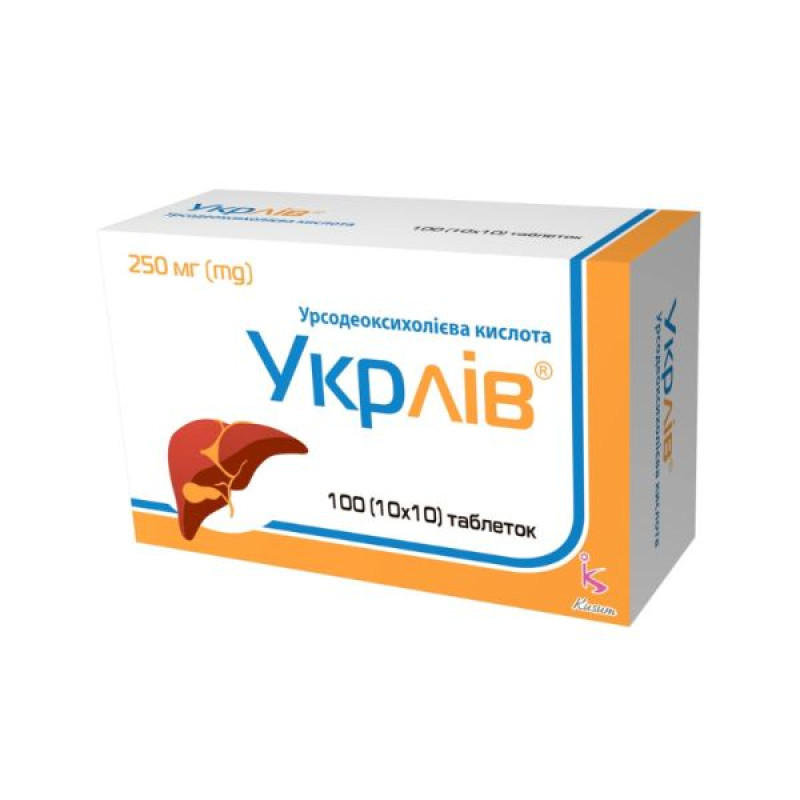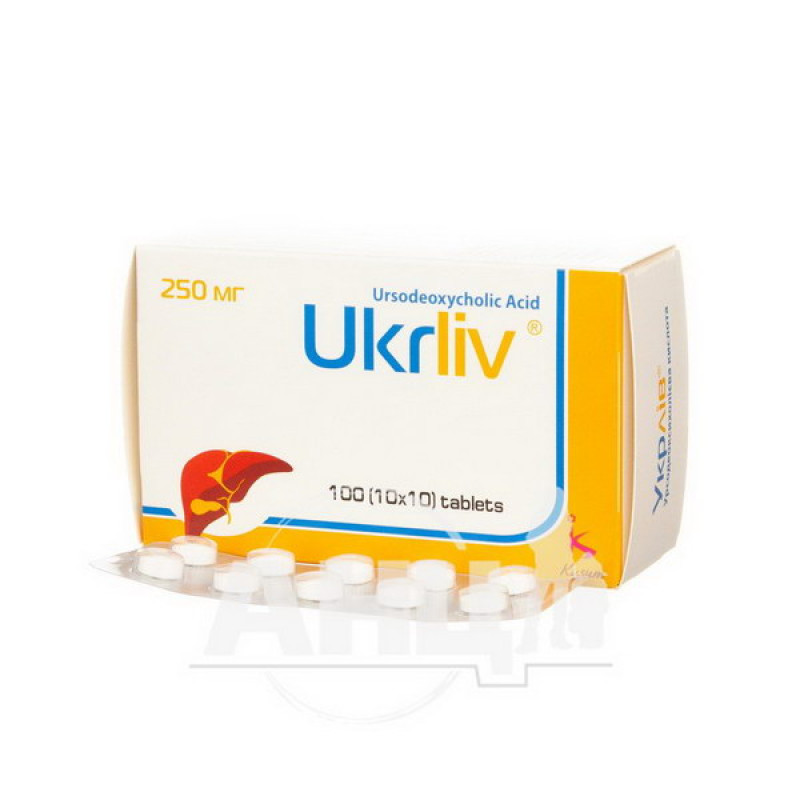Ukrliv tablets 250 mg blister No. 100

Instructions for use Ukrliv tablets 250 mg blister No. 100
Composition
active ingredient: ursodeoxycholic acid;
1 tablet contains 250 mg of ursodeoxycholic acid;
excipients: microcrystalline cellulose, sodium starch glycolate (type A), povidone K-30, magnesium stearate.
Dosage form
Pills.
Main physicochemical properties: round biconvex tablets of white color, smooth on both sides.
Pharmacotherapeutic group
Drugs used for the treatment of the liver and biliary tract. Drugs used in biliary pathology. ATX code A05A A02.
Drugs used in liver disease, lipotropic substances. ATC code A05B.
Pharmacological properties
Pharmacodynamics
Small amounts of ursodeoxycholic acid have been found in human bile. After oral administration, ursodeoxycholic acid reduces the cholesterol saturation of bile by inhibiting its absorption in the intestine and reducing cholesterol secretion into the bile. It is possible that due to the dispersion of cholesterol and the formation of liquid crystals, the gradual dissolution of gallstones occurs.
According to current knowledge, the effect of ursodeoxycholic acid in liver diseases and cholestasis is believed to be due to the relative replacement of lipophilic, detergent-like toxic bile acids with hydrophilic cytoprotective non-toxic ursodeoxycholic acid, improvement of the secretory capacity of hepatocytes, and immunoregulatory processes.
Application to children.
Cystic fibrosis.
There is information available from clinical reports regarding the long-term use of ursodeoxycholic acid (up to 10 years) in the treatment of children with hepatobiliary disorders associated with cystic fibrosis. There is evidence that the use of ursodeoxycholic acid can reduce proliferation in the bile ducts, stop the progression of histological changes, and even eliminate hepatobiliary changes if therapy is started in the early stages of cystic fibrosis. For best effectiveness, treatment with ursodeoxycholic acid should be started immediately after the diagnosis of cystic fibrosis is clarified.
Pharmacokinetics
When administered orally, ursodeoxycholic acid is rapidly absorbed in the jejunum and upper ileum by passive transport and in the terminal ileum by active transport. The absorption rate is usually 60-80%. After absorption, the bile acid undergoes almost complete conjugation in the liver with the amino acids glycine and taurine and is then excreted in the bile. The first-pass clearance through the liver is up to 60%.
Depending on the daily dose and the underlying liver disorder or condition, the more hydrophilic ursodeoxycholic acid accumulates in the bile. At the same time, there is a relative decrease in other more lipophilic bile acids.
Under the influence of intestinal bacteria, partial degradation occurs to 7-ketolithocholic and lithocholic acids. Lithocholic acid is hepatotoxic and causes damage to the liver parenchyma in some animal species. In humans, only a small amount is absorbed, which is sulfated in the liver and thus detoxified before being excreted in the bile and, finally, in the feces.
The biological half-life of ursodeoxycholic acid is 3.5-5.8 days.
Indication
For the dissolution of radiopaque cholesterol gallstones no larger than 15 mm in diameter in patients with a functioning gallbladder, regardless of the presence of gallstone(s).
For the symptomatic treatment of primary biliary cirrhosis (PBC) in the absence of decompensated liver cirrhosis.
For the treatment of hepatobiliary disorders in cystic fibrosis in children aged 6 years and older.
Contraindication
Hypersensitivity to any of the ingredients of the drug. Acute inflammation of the gallbladder or bile ducts. Obstruction of the bile duct (obstruction of the common bile duct or cystic duct). Frequent episodes of hepatic colic. Radiopaque calcified gallstones. Impaired gallbladder contractility. Decompensated cirrhosis. Unsuccessful outcome of portoenterostomy or lack of adequate bile outflow in children with biliary atresia.
Interaction with other medicinal products and other types of interactions
Ukrliv® should not be used simultaneously with cholestyramine, colestipol or antacids containing aluminum hydroxide and/or smectite (aluminum oxide), as these drugs bind ursodeoxycholic acid in the intestine and thus prevent its absorption and reduce its effectiveness. If the use of drugs containing one of the listed substances is necessary, they should be taken at least 2 hours before or 2 hours after taking Ukrliv.
Ukrliv® may increase the absorption of cyclosporine from the intestine. In patients taking cyclosporine, the doctor should check the concentration of this substance in the blood and, if necessary, adjust the dose of cyclosporine.
Ursodeoxycholic acid reduces the maximum plasma concentration (Cmax) and the area under the concentration-time curve (AUC) for the calcium antagonist nitredipine.
Based on this, as well as a report of one case of interaction with dapsone (reduced therapeutic effect) and in vitro studies, it can be concluded that ursodeoxycholic acid induces the cytochrome P450 3A enzyme, which metabolizes drugs.
Therefore, in the case of concomitant use of drugs that are metabolized with the participation of this enzyme, special caution should be exercised and it should be borne in mind that dose adjustment is possible if necessary.
Application features
Ukrliv® tablets should be taken under the supervision of a doctor.
During the first 3 months of therapy, the physician should monitor liver function parameters AST (SGOT), ALT (SGPT) and γ-GT every 4 weeks. This allows to determine whether or not an appropriate response to treatment is present in patients with PBC, as well as to identify potential liver dysfunction in a timely manner, especially in patients with advanced PBC.
Use for dissolving cholesterol gallstones.
6-10 months after the start of treatment, oral cholecystography should be used to determine the general appearance of the stone and the appearance of gallbladder obstruction in the patient's standing and supine positions (ultrasound). This is necessary to assess therapeutic progress and for the timely detection of possible calcification of gallstones.
The drug should not be taken by patients with a gallbladder that is not visualized by X-ray methods, with calcified stones, impaired gallbladder contractility, or those who have frequent biliary colic.
Treatment of patients with late-stage PBC.
Cases of decompensated liver cirrhosis, which partially regressed after discontinuation of therapy, have been reported extremely rarely.
In patients with PBC, very rarely, symptoms may worsen at the beginning of treatment, for example, itching may increase. In such cases, the dose of Ukrliva 250 mg tablets should be reduced to two Ukrliva 250 mg tablets per day; then the dose should be gradually increased as described in the section “Method of administration and dosage”.
If diarrhea develops, the dosage should be reduced; if diarrhea becomes persistent, treatment should be discontinued.
Ability to influence reaction speed when driving vehicles or other mechanisms
No effect on the ability to drive or use machines was observed.
Use during pregnancy or breastfeeding
Animal studies have not shown any effect of ursodeoxycholic acid on fertility. There are no data on the effect on human fertility.
There are insufficient data on the use of ursodeoxycholic acid in pregnant women. Animal studies have shown reproductive toxicity in early pregnancy. Ukrliv® 250 mg tablets should not be used in pregnancy unless clearly necessary. Women of childbearing potential should only take the drug if reliable contraception is used.
It is recommended to use non-hormonal contraceptives or oral contraceptives with a low estrogen content. Patients receiving Ukrliv®, 250 mg tablets, for the dissolution of gallstones should use effective non-hormonal contraceptives, since hormonal oral contraceptives may increase the risk of gallstone formation. Pregnancy should be excluded before starting treatment.
According to several recorded cases of use of the drug in breastfeeding women, the content of ursodeoxycholic acid in milk was extremely low, so no adverse effects should be expected in infants.
Method of administration and doses
For patients weighing less than 47 kg or those who have difficulty swallowing tablets, Ukrliva may be used in another dosage form (suspension).
To dissolve cholesterol gallstones
Approximately 10 mg ursodeoxycholic acid/kg body weight per day (see Table 1)
Table 1
| Body weight | Number of tablets |
up to 60 kg 61-80 kg 81-100 kg more than 100 kg | 2 3 4 5 |
The tablets should be swallowed without chewing, with a small amount of liquid, in the evening before bedtime.
The tablets must be taken regularly.
The time required for gallstones to dissolve is usually 6-24 months. If a reduction in the size of the gallstones is not observed after 12 months of treatment, therapy should not be continued.
The success of the treatment should be checked every 6 months by ultrasound or X-ray. Additional tests should be performed to check whether calcification of the stones has occurred over time. If this occurs, treatment should be discontinued.
For the symptomatic treatment of primary biliary cirrhosis (PBC)
The daily dose depends on body weight and varies from 3 to 7 tablets (14±2 mg ursodeoxycholic acid per kilogram of body weight), see Table 2.
During the first 3 months of treatment, Ukrliva tablets should be taken throughout the day, dividing the daily dose into several doses. If liver function indicators improve, the daily dose can be taken once a day, in the evening.
Table 2
| Ukrliv®, 250 mg tablets | ||||
| first 3 months | in the future | |||
| morning | day | evening | evening (once a day) | |
| 47-62 | 1 | 1 | 1 | 3 |
| 63-78 | 1 | 1 | 2 | 4 |
| 79-93 | 1 | 2 | 2 | 5 |
| 94-109 | 2 | 2 | 2 | 6 |
| more than 110 | 2 | 2 | 3 | 7 |
The tablets should be swallowed whole with liquid. The drug should be used regularly.
The use of Ukrliv in primary biliary cirrhosis is possible for a long period.
In patients with primary biliary cirrhosis, a rare worsening of clinical symptoms, such as increased itching, may occur at the beginning of treatment. In this case, therapy should be continued at one tablet of Ukrliva per day, and then the dose should be gradually increased (increase the daily dose by one tablet of Ukrliva every week until the indicated dosage regimen is reached).
Application to children.
Children with cystic fibrosis aged 6 years and older.
The dose is 20 mg/kg/day, divided into 2-3 doses, with a subsequent increase in dose to 30 mg/kg/day if necessary.
Table 3
Body weight (kg) | Daily dose (mg/kg) | Ukrliv®, 250 mg tablets | ||
| Morning | Day | Evening | ||
| 20-29 | 17-25 | 1 | - | 1 |
| 30-39 | 19-25 | 1 | 1 | 1 |
| 40-49 | 20-25 | 1 | 1 | 2 |
| 50-59 | 21-25 | 1 | 2 | 2 |
| 60-69 | 22-25 | 2 | 2 | 2 |
| 70-79 | 22-25 | 2 | 2 | 3 |
| 80-89 | 22-25 | 2 | 3 | 3 |
| 90-99 | 23-25 | 3 | 3 | 3 |
| 100-109 | 23-25 | 3 | 3 | 4 |
| >110 | 3 | 4 | 4 |
Children
For the dissolution of cholesterol gallstones and symptomatic treatment of PBC
There are no fundamental age restrictions for the use of Ukrliv® in children, but children weighing less than 47 kg and/or children who have difficulty swallowing are recommended to use Ukrliv® in the form of a suspension.
For the treatment of hepatobiliary disorders in cystic fibrosis
Use for children aged 6 and over.
Overdose
In case of overdose, diarrhea is possible. Other symptoms of overdose are unlikely, since the absorption of ursodeoxycholic acid decreases with increasing dose and therefore most of the dose taken is excreted in the feces.
If diarrhea occurs, the dose should be reduced, and if diarrhea is persistent, therapy should be discontinued.
Treatment is symptomatic and involves restoring fluid and electrolyte balance.
Additional information regarding special patient groups.
Long-term therapy with high doses of ursodeoxycholic acid (28-30 mg/kg/day) in patients with primary sclerosing cholangitis (off-label use) was associated with a higher incidence of serious adverse events.
Adverse reactions
Gastrointestinal: pasty stools, diarrhea, severe abdominal pain in the right hypochondrium.
Liver and gallbladder: calcification of gallstones; decompensation of liver cirrhosis.
Immune system disorders: hypersensitivity reactions, including rash (urticaria).
Expiration date
3 years.
Storage conditions
Store at a temperature not exceeding 25 °C in the original packaging.
Keep out of reach of children.
Packaging
10 tablets in a blister; 10 blisters in a cardboard box.
Vacation category
According to the recipe.
Producer
"KUSUM FARM" LLC.
Location of the manufacturer and its business address
40020, Ukraine, Sumy region, Sumy city, Skryabina st., 54.
There are no reviews for this product.
There are no reviews for this product, be the first to leave your review.
No questions about this product, be the first and ask your question.








